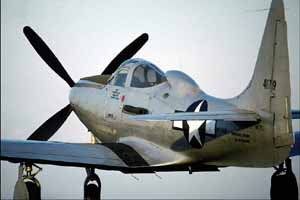Bell P-63 Kingcobra
U.S. Fighter & Ground Attack
 |
The Ghost Squadron's P-63 Kingcobra. Image source: The Confederate Air Force Ghost Squadron CD-ROM produced by Corel. Photos by Bill Crump. |
Both the P-39 and later P-63 were unusual in design and appearance, compared with other contemporary American fighters. With the engine mounted behind the cockpit, the propeller was driven by a long driveshaft, which passed under the pilot and between his legs. The cockpit also featured automobile-like doors, complete with roll down windows on many models. Finally, the aircraft sat on a tricycle landing gear, with a nosewheel instead of the more common tailwheel.
The prototype Kingcobra, the XP-63A was first flown on 26 April, 1943, and delivery of production P-63As began in October of that year. More than 3,300 P-63s of all types were built, but more than 2,400 went to Russia and another 300 to the Free French Air Force. It is unlikely that any P-63s were used in combat operations by the USAAF.
With its 37-mm automatic cannon firing through the engine’s crankshaft, the P-63 packed a potent punch when used as a ground attack aircraft, the cannon shells being able to destroy enemy trucks, trains and even tanks with just a few hits. Early versions of the Kingcobra carried only 30 rounds of ammunition for the cannon but later versions increased this to 58.
Probably the oddest use of a fighter aircraft came with the modification of a number of P-63s for Operation Pinball, fitted with extra thick skin over the top of the fuselage, bulletproof glass for the cockpit and steel grills and guards over engine air intakes and coolant radiators.
This "armor" allowed the Pinball aircraft to be fired at by aerial gunners in training, with special frangible (breakable) bullets. The idea was that the gunners would get practice at shooting at real live fast-moving aircraft attacking their training bombers. Each frangible bullet was supposed to advance a hit counter in the target aircraft, showing how often the gunner was on target. In addition, a light mounted in the nose of the propeller spinner was supposed to flash with each hit!
Specifications
| One Pilot
One Allison V-1710-93/95 Engine One 37 mm Cannon Max. Speed 408 mph @ 25,000 feet Climb to 25,000 ft in 7.3 minutes |
Length 32' 8" Max. Weight 10,500 lbs Normal Fuel 126 gallons Normal Range 450 miles |